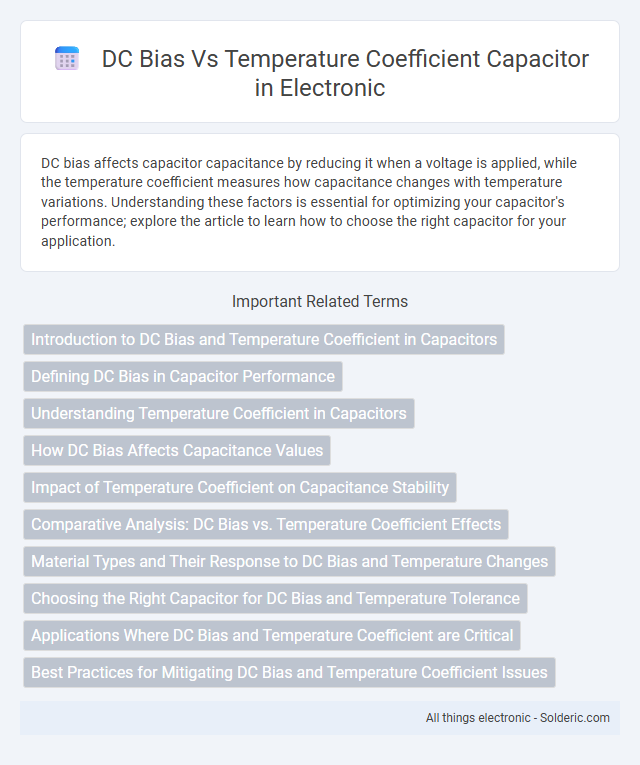DC bias affects capacitor capacitance by reducing it when a voltage is applied, while the temperature coefficient measures how capacitance changes with temperature variations. Understanding these factors is essential for optimizing your capacitor's performance; explore the article to learn how to choose the right capacitor for your application.
Comparison Table
| Feature | DC Bias Capacitor | Temperature Coefficient Capacitor |
|---|---|---|
| Definition | Capacitor affected by applied DC voltage causing capacitance variation | Capacitor with capacitance change due to temperature variations |
| Primary Impact | Capacitance reduction under DC voltage stress | Capacitance shift based on temperature fluctuations |
| Measurement Unit | Capacitance change (%) vs DC voltage | ppm/degC or % capacitance change per degC |
| Key Parameter | DC Bias Characteristic Curve | Temperature Coefficient (TCC) |
| Typical Use Case | High voltage circuits, RF circuits | Precision circuits, temperature-sensitive applications |
| Material Influence | Dielectric type (e.g., X7R, C0G) affects DC bias behavior | Dielectric composition determines temperature coefficient |
| Example Values | Capacitance drop up to 30% at rated voltage (e.g., X7R) | TCC ranges from +-5 ppm/degC (C0G) to +-560 ppm/degC (X7R) |
Introduction to DC Bias and Temperature Coefficient in Capacitors
DC bias in capacitors refers to the effect of a constant direct current voltage on the capacitance value, often causing a reduction in capacitance when a voltage is applied. Temperature coefficient in capacitors quantifies the change in capacitance relative to temperature variations, typically expressed in parts per million per degree Celsius (ppm/degC). Understanding both DC bias and temperature coefficient is crucial for selecting capacitors in applications requiring stable performance under varying electrical and thermal conditions.
Defining DC Bias in Capacitor Performance
DC bias in capacitor performance refers to the reduction in capacitance value when a direct current voltage is applied, causing dielectric material polarization changes. The temperature coefficient of a capacitor indicates how its capacitance varies with temperature fluctuations, impacting stability and reliability in circuits. Understanding DC bias effects alongside temperature coefficients ensures your capacitors maintain optimal performance under varying electrical and thermal conditions.
Understanding Temperature Coefficient in Capacitors
Temperature coefficient in capacitors quantifies how capacitance changes with temperature, expressed in parts per million per degree Celsius (ppm/degC). DC bias affects capacitance by shifting the electric field, but temperature coefficient specifically measures stability across varying thermal conditions. Understanding this parameter helps engineers select capacitors with minimal capacitance variance under thermal stress, ensuring reliable circuit performance.
How DC Bias Affects Capacitance Values
DC bias causes a reduction in capacitance values in many ceramic capacitors due to the nonlinear dielectric materials used, particularly in class II and III dielectrics such as X7R and Y5V. As the applied DC voltage increases, the effective dielectric constant decreases, leading to a capacitance drop that can exceed 20% depending on the specific capacitor type and voltage level. Temperature coefficient capacitors, often using class I dielectrics like C0G/NP0, exhibit minimal DC bias effects and maintain stable capacitance across varying voltages and temperatures.
Impact of Temperature Coefficient on Capacitance Stability
The temperature coefficient of a capacitor significantly impacts capacitance stability by defining how much the capacitance value changes with temperature variations. Capacitors with a low temperature coefficient, such as C0G/NP0 types, maintain consistent capacitance across a wide temperature range, ensuring reliable circuit performance. Your choice of capacitor should consider the temperature coefficient to minimize drift and maintain precision in temperature-sensitive applications.
Comparative Analysis: DC Bias vs. Temperature Coefficient Effects
The performance of capacitors is significantly influenced by both DC bias and temperature coefficient, where DC bias causes capacitance reduction under applied voltage stress, often leading to non-linear behavior in ceramic capacitors. Temperature coefficient defines how capacitance varies with temperature changes, impacting stability and tolerance across operating environments. Comparative analysis shows DC bias primarily affects capacitance at high voltages, while temperature coefficient influences performance over varying thermal conditions, requiring careful selection based on application-specific electrical and thermal demands.
Material Types and Their Response to DC Bias and Temperature Changes
Ceramic capacitors with Class 2 dielectric materials like X7R or Y5V exhibit significant capacitance reduction under DC bias and temperature fluctuations due to their ferroelectric properties. Class 1 dielectrics such as C0G/NP0 maintain stable capacitance with minimal variation, providing superior performance for precision applications exposed to varying temperatures and DC voltages. Understanding these material characteristics allows you to select capacitors that ensure reliability and accuracy in circuits subjected to combined DC bias and thermal changes.
Choosing the Right Capacitor for DC Bias and Temperature Tolerance
Selecting the right capacitor involves understanding both DC bias effects and temperature coefficient ratings to ensure stable performance in your circuit. Capacitors with low DC bias characteristics maintain capacitance under voltage stress, while those with favorable temperature coefficients tolerate fluctuations without significant value changes. Prioritize capacitors that balance minimal capacitance loss under DC bias with temperature coefficients suited to your device's operating environment.
Applications Where DC Bias and Temperature Coefficient are Critical
Capacitors with specific DC bias and temperature coefficients are crucial in high-frequency RF circuits, precision timing devices, and power supply filters where stable capacitance under varying voltage and temperature ensures consistent performance. Your selection impacts the reliability of sensitive applications like telecommunications and aerospace systems, where capacitors must maintain capacitance despite changes in environmental conditions. Understanding the interplay between DC bias and temperature coefficient helps optimize circuit stability and longevity in mission-critical electronic designs.
Best Practices for Mitigating DC Bias and Temperature Coefficient Issues
Select capacitors with low DC bias characteristics such as C0G/NP0 or X7R dielectrics to minimize capacitance loss under voltage stress. Implement temperature-compensated designs using materials with stable temperature coefficients, ensuring consistent performance across operating ranges. Employ circuit techniques like derating and parallel capacitor arrays to reduce the impact of DC bias and temperature variations on circuit stability.
DC bias vs temperature coefficient capacitor Infographic

 solderic.com
solderic.com